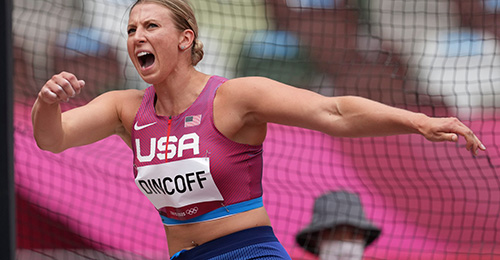Relays
Chris Faust
Head Boys and Girls Track Coach
Cherokee Trail High School
Relay Success at Cherokee Trail:
School Records:
4x100m: 41.73 Tasker, Jones, Walker, Dickens (2009)
4x200m: 1:25.61 Mars, White, Arnold, Singleton (2013)
4x400m: 3:16.54 Bailey, Arnold, Mars, Singleton (2013)
4x800m: 8:02.10 Fiala, Rauh, Hebert, Dillenbeck (2010)
Relay State Champions:
4x100m: 2009, 2010
4x200m: 2007, 2010, 2013
4x400m: 2006, 2007, 2010, 2013
Overall Team State Champions: 2007 (4A), 2013 (5A)
Cherokee Trail Relay Philosophy:
-Track and Field is a TEAM SPORT, and our ultimate goal is to try and score points for our team and win track meets.
-Relays give us the opportunity to score points with teamwork that we may not be able to score in open events.
***In the 12 years of our schools existence, we’ve only had one individual State Champion, but 23
CTHS male athletes have been members of State Championship winning relays.***
***Of the 23 athletes, only 13 ever qualified for an open event at the State Meet, and only 7 ever
scored in that open event.****
-Coaches will put together relays that give our team the best possible opportunity for success.
-Athletes compete with each other for the right to be on a relay.
-RELAY SPOTS ARE NOT GIVEN, THEY ARE EARNED!!!
It Starts with a Great Staff:
-Brian Arnold, Tom Southall, John Green, Eric Gutjahr
-multiple State Championships as Head or Assistant Coaches
-Monte Thelen, Seneca Holmes, Josh Tate
-football coaches and physical education teachers
-great support of the track program
Before the Season:
-Be visible
-Try to attend at least one athletic contest for every team at the school
-Talk to every student that you can!
-Attend track clinics
-CTHS sprint workouts have been influenced by several presentations from track clinics
(TJ Henderson, Teenan Anderson, Barbara Crousen, Mark Brady)
-as have our techniques involving relays (Stuart Leinemann, Phil Wollbrink, Pat Busteed)
-Talk to your former athletes competing at the collegiate level
-ideas for new drills and workouts
-If you can, compete during the indoor season
-Colorado indoor season
-Simplot Games, Great Southwest Classic
Value of the Indoor Season:
-Motivation for athletes to work out
-Gives you an extra training cycle
-November to February
-Even though indoor relay exchanges are different, it allows athletes to work on the timing of relay exchanges.
-Practicing relay exchanges are fun, but can also incorporate conditioning
Indoor Relay Workout:
-Blessed with great facilities, but these could be modified for a lot of school hallways
-Typical workout: continuous relay of 6-8x150m
-Athletes run hard getting/receiving the baton, and then float in the middle
-Mix up the order halfway through the workout
-Practice outdoor 4x100m handoffs, not the ones we will use at Simplot
-It’s a workout the kids look forward to doing
4x100m and 4x200m Relays
-Basic Principles:
1. Blind handoffs
2. Silent exchange
3. Always right, left, right, left
4. Always give the incoming runner the same amount of steps (4x100m: 8 steps, 4x200m: 6 steps)
(These first 4 steps allow us to plug in a replacement on a relay at the last minute, and trust
that the baton will get around the track.)
5. Hold the baton at the bottom
6. Run hard all the way through the exchange zone
7. If the baton drops, pick it up and run, worry about a DQ later
Incoming Runner
-Run hard and maintain speed through the entire zone
-“Run over them if you have to”
-1st and 3rd legs: stay on the inside of the lane
-2nd and 4th legs: stay on the outside of the lane
-Allows the incoming runner to run next to the outgoing runner if necessary
-Don’t attempt to give the baton until the outgoing runner has put up their hand
-In a steady motion, “punch” the baton into the outgoing runner’s hand
-give them the top of the baton
-Don’t release the baton until you are sure the outgoing runner has possession of it.
- DO YOUR JOB!
Outgoing Runner
-Mark your take-off point
-4x100m: 8 steps (5 steps in front of the acceleration triangle, 3 steps behind)
-4x200m: 6 steps (3 steps in front of the acceleration triangle, 3 steps behind)
-Big piece of tape (We use bright neon tape that stands out on the track)
-Good take off position
-Be able to see take-off mark
-Feet forward, in an active stance
-Take off only when incoming runner has reached the take-off mark
-Trust your mark and your teammates!
-Sprint as if the gun went off in an open sprint
-Throw your hand up at the proper time (3 hard steps)
-Good arm position
-High and off the shoulder
-Thumb down, palm flat and steady
-DO YOUR JOB!
4x100m and 4x200m Practice
-Create new exchange zones on the track
-Tape acceleration triangles (35m) from starting line
-Tape exchange zones (20m) from acceleration triangles
-Simulating the 4x200m exchange
-4x150m full relays (usually on Tuesday)
-Gives a good idea of race day speed coming into the exchange zone
-Simulating the 4x100m exchange
-4x50m (during the week)
-2x50m (day before meet, in the exchange zone the runners will use on Saturday)
-For both 4x200m and 4x100m, we usually go with at least two groups at the same time
-Puts athletes in competition with each other
-Allows coaches to compare athletes
-Towards the end of the season, adjust the steps for athletes you know will be on championship relays
-Some athletes need more or less steps
-Have your fastest runners run longer legs of the relays
4x400m and 4x800m relays
-Open exchanges
-Right to left, then crossover to right hand
-Incoming Runner
-Finish the race
-Run all the way through, make sure traffic has passed before stepping off the track
-Stay on the inside of the lane
-Don’t put the baton out until the outgoing runner’s hand is up
-Proper placement of the baton
-Don’t release the baton until the outgoing runner has control of it
-DO YOUR JOB!
4x400m and 4x800m relays (continued)
-Outgoing runner
-Take off mark
-Three steps in the 4x400m, 2-3 steps in the 4x800m
-Good take off position
-Facing the infield, outside of the lane, feet facing forward, left hand outstretched (BIG TARGET)
-Pay attention to order of incoming runners, be prepared to slide down into inside lane
-Be vocal, and make sure incoming runner knows where you are
-Proper arm placement
-High, just off the shoulder, thumb up and palm flat and steady
-Once the baton is in hand, switch it to the right hand
-Sprint to the break point
-DO YOUR JOB!
4x400m and 4x800m Practice
-Early season
-Can be incorporated into conditioning sessions
-6-8x200m continuous relays (5-6 runners)
-Gives each athlete about 2-3 minutes between 200m
-Works technique, and the ability to gauge the speed of the incoming runner
-Rest of the season
-Multiple groups of two man teams
-Vary speed and order
-Best way to gauge incoming runner’s speed is repetition
-Sprint for the curve
Coaches’ Responsibilities
-Put together the best relays possible
-Times in open events is not the only factor
-Competitiveness, ability to respond to pressure
-Practice habits and work ethic (relay spots are earned)
-Give athletes as many opportunities as possible
-Incorporate into winter conditioning
-Simulated 4x100m and 4x200m in practice
-Run as many competitive relays in JV meets as possible
-Stress the team aspect of track and field
-Perfect combination of individual and team sport
-Relays can be the best way for us to score points
-You have three teammates counting on you to get the baton around!
Relay Strategy
-4x100m, 4x200m, 4x400m
-Leadoff leg
-Excellent out of blocks (hurdlers, short sprint specialists)
-Maybe not the best at receiving the baton
-2nd runner
-Maybe your fastest runner
-If we don’t have a true closer, we want to be in the race as long as possible
-In the 4x400m, we want someone who will fight to beat people to the curve
-3rd runner
-Good at running the curve
-If needed, can maintain our position
-4th runner
-Strong runner, someone who wants the pressure on them
-4x800m
-More of a sprint than ever
-Try to move up sprinters who may not make your varsity in the 100m-400m
-It might be worth it to put your best runner first
-Helps to avoid traffic during the exchanges
-Forces the rest of the relay to get out and race


 Larry Chavez is the 112th inductee into the NMAA Hall of Fame, with a career in education that spanned over 38 years. He devoted his entire career to the youth of New Mexico.....
Larry Chavez is the 112th inductee into the NMAA Hall of Fame, with a career in education that spanned over 38 years. He devoted his entire career to the youth of New Mexico..... Newell, a graduate from Highland High School and 3-time State Champion, has attended two Olympic games for team Canada.
Newell, a graduate from Highland High School and 3-time State Champion, has attended two Olympic games for team Canada. Former New Mexico State volunteer assistant track and field coach Rachel Dincoff reached the pinnacle of her event...
Former New Mexico State volunteer assistant track and field coach Rachel Dincoff reached the pinnacle of her event...